James Maliszewski's Blog, page 83
February 17, 2023
My Top 10 Non-D&D RPGs (Part II)
Part I of this list can be found here.
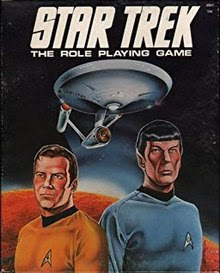 5. Star Trek the Role Playing Game
5. Star Trek the Role Playing GameStar Trek is my original fandom. I started watching the Original Series in reruns on a local TV channel growing up and instantly fell in love with it. As a kid, I read everything about or related to the show that I could and one of my proudest possessions was a gold Starfleet uniform shirt that I probably wore far too often. Consequently, the appearance of FASA's 1982 was a major event for me. I bought a copy as soon as I could and immediately started refereeing a long-running campaign with my friends. In most respects, FASA's rules were nothing special – a fairly basic percentile-driven system – but they included two things that set them apart in my opinion. The first was the lifepath character generation system, which helped players get a handle on who their characters were before the campaign began. The second was a character-based starship combat system that nicely evoked the feel of ship-to-ship combat from the TV series. These, combined with the obvious love the game showed toward its source material, makes Star Trek the Role Playing Game one of my favorite RPGs even today.
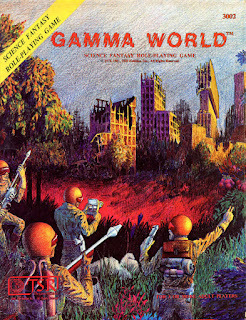 4. Gamma World
4. Gamma WorldI'm a sucker for post-apocalyptic settings, so it was natural that Gamma World would appeal to me. Nowadays, it's pretty common among gamers to make fun of GW and its rather, shall we say, idiosyncratic take on the End Times. On the one hand, I can understand that. From the vantage point of the present, Gamma World, with its mutant chicken-men and rabbits that can turn metal to rubber with a touch, certainly might appear silly. On the other hand, I think what's often misunderstood about the game is that it actually owes a lot more to the "dying earth" fantasy sub-genre than straight science fictional speculation. Gamma World postulates that the End Times come several hundred years hence, when all sorts of technological marvels exist and have made Earth quite unlike our own age. After the Fall, Earth becomes genuinely weird, thanks to artificial intelligences, mutagenic substances, and reality warping weapons. That's precisely why I continue to love it and why I hope to have the chance to referee another campaign of it one day.
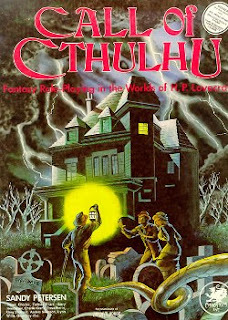 3. Call of Cthulhu
3. Call of CthulhuLike Pendragon, Call of Cthulhu is another "perfect" game in the way that it marries its game mechanics and its source material. Of course, despite its original subtitle – "Fantasy Role-Playing in the Worlds of H.P. Lovecraft" – Call of Cthulhu's source material is much broader than simply the works of HPL. As I have argued before, CoC owes a great deal to Lovecraft's admirer, August Derleth, whose literary vision is far less bleak than that of his hero. An RPG based solely on Lovecraft's nihilistic cosmicism would certainly be horrific, but would it be fun to play? I personally don't think so, which is why Sandy Petersen was wise to have leavened the existential gloom of Lovecraft with healthy doses of Derlethian optimism. In any event, I've played a lot of Call of Cthulhu over the years and hope to do so again in the future. It is, hands down, my favorite horror roleplaying game and yet another reminder that Chaosium is one of the great publishers of our hobby
2. Empire of the Petal Throne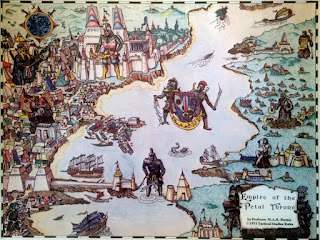 This is the only game on this list that I didn't play in my youth. Indeed, I never had the opportunity to play Empire of the Petal Throne until a few years ago, when I began my House of Worms campaign. Now, just shy of eight years of continuous play with a consistent group of players, there can be little doubt that EPT is one of my favorite RPGs. Naturally, its remarkable setting, Tékumel, is a big part of why, but there have been several other Tékumel games released over the years and none of them has ever had the staying power of Empire of the Petal Throne. In large part, that's because EPT is so simple. Its rules are easy to remember and use, which is important when playing in a setting as complex and detailed as Tékumel and I suspect my players would agree.
This is the only game on this list that I didn't play in my youth. Indeed, I never had the opportunity to play Empire of the Petal Throne until a few years ago, when I began my House of Worms campaign. Now, just shy of eight years of continuous play with a consistent group of players, there can be little doubt that EPT is one of my favorite RPGs. Naturally, its remarkable setting, Tékumel, is a big part of why, but there have been several other Tékumel games released over the years and none of them has ever had the staying power of Empire of the Petal Throne. In large part, that's because EPT is so simple. Its rules are easy to remember and use, which is important when playing in a setting as complex and detailed as Tékumel and I suspect my players would agree. 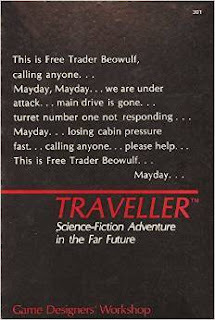
1. Traveller
Surprising precisely no one reading this blog, Traveller is at the top of this list for too many reasons to list. For our present purposes, I will focus on two. First, Traveller is the only game besides D&D whose rules I know well enough that I can play it without having to refer to any rulebooks. After so many years and so many campaigns, slipping back into Traveller is effortless. Second, Traveller is the game that served as my gateway to professional writing. Way back in the early '90s, when I was still in college, I made the acquaintance of other Traveller fans who encouraged me to submit articles to GDW's Challenge. I was not only successful in this, but doing so eventually opened the door to my writing not just for Traveller but for many other games as well. Traveller is and probably always will be my "true love" when it comes to RPGs. I am absolutely certain that I will play many more campaigns of it in the years to come.
My Top 10 Non-D&D Games (Part II)
Part I of this list can be found here.
 5. Star Trek the Role Playing Game
5. Star Trek the Role Playing GameStar Trek is my original fandom. I started watching the Original Series in reruns on a local TV channel growing up and instantly fell in love with it. As a kid, I read everything about or related to the show that I could and one of my proudest possessions was a gold Starfleet uniform shirt that I probably wore far too often. Consequently, the appearance of FASA's 1982 was a major event for me. I bought a copy as soon as I could and immediately started refereeing a long-running campaign with my friends. In most respects, FASA's rules were nothing special – a fairly basic percentile-driven system – but they included two things that set them apart in my opinion. The first was the lifepath character generation system, which helped players get a handle on who their characters were before the campaign began. The second was a character-based starship combat system that nicely evoked the feel of ship-to-ship combat from the TV series. These, combined with the obvious love the game showed toward its source material, makes Star Trek the Role Playing Game one of my favorite RPGs even today.
 4. Gamma World
4. Gamma WorldI'm a sucker for post-apocalyptic settings, so it was natural that Gamma World would appeal to me. Nowadays, it's pretty common among gamers to make fun of GW and its rather, shall we say, idiosyncratic take on the End Times. On the one hand, I can understand that. From the vantage point of the present, Gamma World, with its mutant chicken-men and rabbits that can turn metal to rubber with a touch, certainly might appear silly. On the other hand, I think what's often misunderstood about the game is that it actually owes a lot more to the "dying earth" fantasy sub-genre than straight science fictional speculation. Gamma World postulates that the End Times come several hundred years hence, when all sorts of technological marvels exist and have made Earth quite unlike our own age. After the Fall, Earth becomes genuinely weird, thanks to artificial intelligences, mutagenic substances, and reality warping weapons. That's precisely why I continue to love it and why I hope to have the chance to referee another campaign of it one day.
 3. Call of Cthulhu
3. Call of CthulhuLike Pendragon, Call of Cthulhu is another "perfect" game in the way that it marries its game mechanics and its source material. Of course, despite its original subtitle – "Fantasy Role-Playing in the Worlds of H.P. Lovecraft" – Call of Cthulhu's source material is much broader than simply the works of HPL. As I have argued before, CoC owes a great deal to Lovecraft's admirer, August Derleth, whose literary vision is far less bleak than that of his hero. An RPG based solely on Lovecraft's nihilistic cosmicism would certainly be horrific, but would it be fun to play? I personally don't think so, which is why Sandy Petersen was wise to have leavened the existential gloom of Lovecraft with healthy doses of Derlethian optimism. In any event, I've played a lot of Call of Cthulhu over the years and hope to do so again in the future. It is, hands down, my favorite horror roleplaying game and yet another reminder that Chaosium is one of the great publishers of our hobby
2. Empire of the Petal Throne This is the only game on this list that I didn't play in my youth. Indeed, I never had the opportunity to play Empire of the Petal Throne until a few years ago, when I began my House of Worms campaign. Now, just shy of eight years of continuous play with a consistent group of players, there can be little doubt that EPT is one of my favorite RPGs. Naturally, its remarkable setting, Tékumel, is a big part of why, but there have been several other Tékumel games released over the years and none of them has ever had the staying power of Empire of the Petal Throne. In large part, that's because EPT is so simple. Its rules are easy to remember and use, which is important when playing in a setting as complex and detailed as Tékumel and I suspect my players would agree.
This is the only game on this list that I didn't play in my youth. Indeed, I never had the opportunity to play Empire of the Petal Throne until a few years ago, when I began my House of Worms campaign. Now, just shy of eight years of continuous play with a consistent group of players, there can be little doubt that EPT is one of my favorite RPGs. Naturally, its remarkable setting, Tékumel, is a big part of why, but there have been several other Tékumel games released over the years and none of them has ever had the staying power of Empire of the Petal Throne. In large part, that's because EPT is so simple. Its rules are easy to remember and use, which is important when playing in a setting as complex and detailed as Tékumel and I suspect my players would agree. 
1. Traveller
Surprising precisely no one reading this blog, Traveller is at the top of this list for too many reasons to list. For our present purposes, I will focus on two. First, Traveller is the only game besides D&D whose rules I know well enough that I can play it without having to refer to any rulebooks. After so many years and so many campaigns, slipping back into Traveller is effortless. Second, Traveller is the game that served as my gateway to professional writing. Way back in the early '90s, when I was still in college, I made the acquaintance of other Traveller fans who encouraged me to submit articles to GDW's Challenge. I was not only successful in this, but doing so eventually opened the door to my writing not just for Traveller but for many other games as well. Traveller is and probably always will be my "true love" when it comes to RPGs. I am absolutely certain that I will play many more campaigns of it in the years to come.
February 16, 2023
My Top 10 Non-D&D RPGs (Part I)
Part II will appear tomorrow.
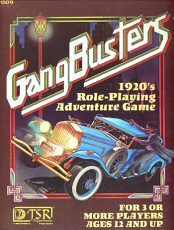 10. Gangbusters
10. Gangbusters
I've always liked the idea of historical RPGs, but, in practice, they're often difficult to pull off. One of their biggest obstacles in my opinion is that players – and referees too – are often at a loss deciding precisely what to do in a past setting. That's not the case with TSR's Gangbusters. For one, it takes place during the gang wars of the USA's Prohibition Era, which naturally lends itself to something more akin to the "adventuring" found in purely fictional worlds. For another, the game's compact 64-page rules give plenty of rules and advice on how to run a campaign. Everything from police procedures to investigative journalism to criminal activities gets its due. Gangbusters is the only historical RPG I've ever played successfully for any length of time and I regularly consider trying to do so again. It's a terrific, underappreciated gem of the first decade of the hobby.
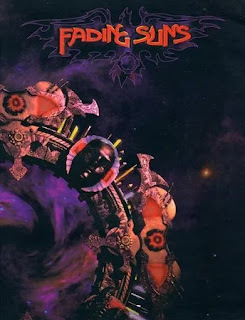
9. Fading Suns
Science fiction has always been my jam, so I don't think anyone will be surprised to see a large number of SF RPGs on this list. That said, Fading Suns is science fiction in the same way that one might call Star Wars science fiction, which is to say, it involves blasters and starships but is otherwise more of a space fantasy. That's not a criticism of Fading Suns, which makes excellent use of a number of thematic and setting elements that are right up my alley, like religion, ancient mysteries, weird technology, feudalism, and more. The game's setting has always been its main strength, since it's never had a rules system with which I was wholly comfortable. Even so, I've had a lot of fun with it over the years, having run a couple of enjoyable campaigns in the late '90s and early 2000s. I hope one day to do it again.
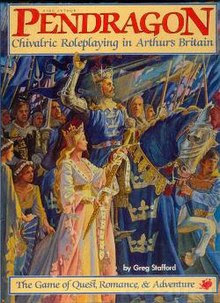 8. Pendragon
8. PendragonPendragon is one of only a handful of RPGs I'd consider "perfect," in the sense that they perfectly marry their mechanics and subject matter. It's for this reason that the game is sometimes considered the late Greg Stafford's masterpiece and I largely agree with that judgment. Stafford managed to achieve with Pendragon something he never quite managed with RuneQuest: the creation of rules that fully immersed the player into the world – and worldview – of the game. That Pendragon's mechanics are quite simple (and mostly straightforward) makes it very easy on both players and the referee to enter a fully realized Arthurian world. I recently had the chance to play Pendragon again over the last couple of years and enjoyed myself greatly. The game remains every bit as good as I remembered its being.
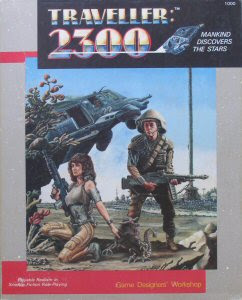
7. Traveller: 2300
Science fiction rears its head again. Traveller: 2300 – later renamed 2300 AD to avoid confusion with its unrelated predecessor – is a game I strongly associate with the last years of high school and the start of my college education. During those years, I was much devoted to it, in large part because I found its setting so compelling. From its interesting (and unexpected) future history to its plausible future technologies to its truly alien aliens, it had everything that I wanted in a SF RPG at the time. Like many other games on this list, Traveller: 2300 suffered a little because of its clunky rules, but it more than made up for it with its compelling vision of a future three centuries hence. I haven't played in this particular SF sandbox in a long time; perhaps I need to change that in the years to come.
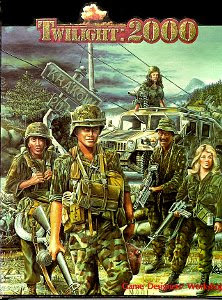 6. Twilight: 2000
6. Twilight: 2000At the time it was released, just as I was starting high school, Twilight: 2000 seemed like a fairly plausible take on the End of the World, certainly when compared to more fanciful post-apocalyptic games like Gamma World. Strangely, that was a big part of the game's appeal to me. Later, it was the way the game and its supplements emphasized the importance of rebuilding civilization after the destruction of World War III that held my attention, making it one of the more hopeful post-apocalyptic RPGs. Twilight: 2000 is one of only a few games on this last that I am currently playing and, in its current iteration, is now firmly within the realm of alternate history (I hope). We've been having a lot of fun with it and I intend to talk more about my experiences with it in future posts.
February 15, 2023
Retrospective: Library Data
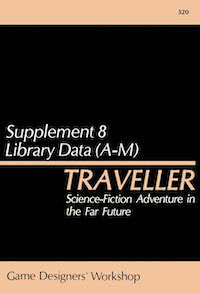 My enduring affection for GDW's science fiction roleplaying game Traveller is a recurring topic of discussion on this blog, as is my similar affection for its Third Imperium setting. No matter how often I've felt that I was ready to "move on" from Traveller, I've never done so for long – and indeed often came back to the game and its setting with renewed enthusiasm. There are a lot of reasons why this is the case, but the primary one, I think, is how well I know both the game's rules and its official setting.
My enduring affection for GDW's science fiction roleplaying game Traveller is a recurring topic of discussion on this blog, as is my similar affection for its Third Imperium setting. No matter how often I've felt that I was ready to "move on" from Traveller, I've never done so for long – and indeed often came back to the game and its setting with renewed enthusiasm. There are a lot of reasons why this is the case, but the primary one, I think, is how well I know both the game's rules and its official setting.That extensive knowledge comes after decades of playing and refereeing, as well as reading and writing about Traveller. I know a great deal about Traveller and can, if given the opportunity, talk at length about its minutiae. In fact, I very much enjoy doing so, since it's a science fiction setting that tickles all my particular fancies, some of which no doubt exist precisely because I've been a fan of Traveller for so long.
Ironically, this extensive knowledge is also why I have in the past attempted to leave Traveller behind. After more than forty-years, the game has acquired an immense collection of facts and details about its Third Imperium setting, facts and details that, within the game, are sometimes called library data. As presented in the game's earliest supplements and scenarios, library data were supposed to be bits of information the player characters could obtain through research, the knowledge of which might aid them in the course of their adventures.
Over time, though, library data became much more than that, as evidenced by a pair of supplements released in 1981 and 1982. Supplement 8: Library Data (A–M) and Supplement 11: Library Data (N–Z) together formed what might be considered the first encyclopedia of the Third Imperium setting. Both of these 48-page booklets contained reams of information about the history, worlds, species, cultures, and technology of the 57th century. While some of this information was simply collected from earlier sources, such as adventures or the pages of The Journal of the Travellers' Aid Society, much of it was entirely new or at least expanded upon information we'd seen previously. The end result was the presentation of an immense, coherent, and very specific far future setting for use with Traveller.
I adored these supplements when they were first released and, for a long time, considered them among the best things every produced for Traveller. What's not to love? Not only did it include a chronology starting 300,000 years in the past, but it also included entries on important historical events within the setting, key worlds within and without the Imperium, all its emperors and empresses, and so much more. For someone like myself, who's always been obsessed with setting detail, the two Library Data supplements were like catnip. I cannot begin to count the hours I spent reading and re-reading them, committing all their entries to memory, to the point that I suspect I know some aspects of the Third Imperium setting better than I do their equivalents in the real world.
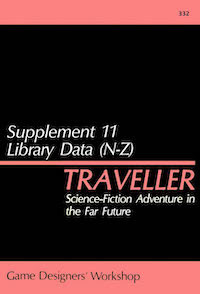
Such knowledge proved very useful to me over the years. My command of this information has certainly made my Traveller sessions more immersive, if my players over the years are to be believed. They also aided me in getting my start as a professional writer of RPG material. My first published works were in the pages of GDW's Challenge magazine, thanks in large part to my ability to spin library data information into Traveller scenarios. This was, after all, the original purpose of library data.
Yet, library data was also a great temptation – at least to someone of my particular bent. It was very easy to turn the creation and study of setting-based trivia into an end in itself rather than an aid to play. During the 1990s, when I was most active in Traveller fandom, I detected a very strong tendency among Traveller's most ardent fans to obsess over library data almost to the exclusion of all other forms of engagement with the game, including play. This is not a behavior exclusive to Traveller fans; I have observed it in Tékumel fans too and have been told by others that it's prevalent elsewhere.
Now, there is nothing wrong with having a game whose setting is rich in detail. As I know only too well, such details can be used to heighten immersion and inspire adventures and those are very good things indeed. They can also displace actual play and discourage newcomers from ever taking an interest in the setting. Recognizing this is one of the reasons why I've frequently abandoned Traveller. I often got the sense that its most fervent fans never really played the game but were only interested in it as a purely intellectual exercise. Even as someone who appreciated the joy that can come from such activity, this repulsed me. A roleplaying game setting – especially one with lots of interesting details – is only good to the extent that it's being used for roleplaying.
This is why I have such mixed feelings about those Library Data supplements. The world building details they contain thrilled me as a younger person and inspired lots of great gaming that I still remember to this day. They're also a trap, one that has too often led me away from actually playing Traveller and down a dead end of simply fixating on its trivia. Older and perhaps a little wiser, I understand this, but I nevertheless remain wary of them and other RPG supplements of a similar sort.
February 14, 2023
"Faaantastic!"
White Dwarf: Issue #65
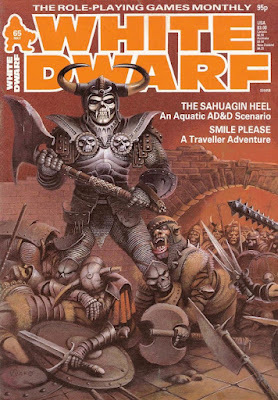 Issue #65 of White Dwarf (May 1985) features a cover by Chris Achilleos derived from a painting that had previously been used in a Fighting Fantasy advertisement (or perhaps they both derive the same painting). This was a common practice for White Dwarf and not in itself noteworthy. I only mention in this instance, because I actually remembered the original FF ad. Ian Livingstone's editorial mentions "a slight decline in fantasy gaming in the USA," which he clarifies as meaning that "the fickle mass market in the USA ... are tired of it." Based on my own memories, this seems about right. The peak fad years of Dungeons & Dragons were largely over and TSR itself was in knee-deep in the struggle between Gary Gygax and the Blume brothers for control of TSR. That said, it certainly didn't feel that way to me at the time.
Issue #65 of White Dwarf (May 1985) features a cover by Chris Achilleos derived from a painting that had previously been used in a Fighting Fantasy advertisement (or perhaps they both derive the same painting). This was a common practice for White Dwarf and not in itself noteworthy. I only mention in this instance, because I actually remembered the original FF ad. Ian Livingstone's editorial mentions "a slight decline in fantasy gaming in the USA," which he clarifies as meaning that "the fickle mass market in the USA ... are tired of it." Based on my own memories, this seems about right. The peak fad years of Dungeons & Dragons were largely over and TSR itself was in knee-deep in the struggle between Gary Gygax and the Blume brothers for control of TSR. That said, it certainly didn't feel that way to me at the time."The Good, the Bad, and the Downright Odd" by Phil Masters is a decent article about the creation and use of non-player characters in superhero RPGs. However, my enjoyment of it was seriously hampered not by anything in its content by its godawful layout, one of the worst in the long history of White Dwarf's godawful layouts. Let your eyes feast upon this:
 More damning than the possibility that this layout could trigger epileptic seizures in the reader, it's almost completely illegible. The combination of colors, especially in the areas that combine a white background with black text and a red overlay, makes the thing almost impossible to read. This isn't just middle age speaking; this was true even in my teen years before I ever owned a pair of glasses. What were they thinking?
More damning than the possibility that this layout could trigger epileptic seizures in the reader, it's almost completely illegible. The combination of colors, especially in the areas that combine a white background with black text and a red overlay, makes the thing almost impossible to read. This isn't just middle age speaking; this was true even in my teen years before I ever owned a pair of glasses. What were they thinking?Fortunately, "Open Box" is as readable as ever. This issue, there are reviews for West End's Paranoia (7 out of 10), which used to be a favorite of mine. Reviewer Marcus L. Rowland quite correctly points out that, though fun, Paranoia is probably not suitable for a "prolonged campaign." Also reviewed are the first three Alien Modules for GDW's Traveller, focusing on the Aslan (9 out of 10), K'Kree (7 out of 10), and Vargr (9 out of 10). Concluding the column are reviews of three different supplements and adventures for use with FASA's Star Trek RPG: The Romulans (8 out of 10), The Orion Ruse (9 out of 10), and Margin of Profit (8 out of10). For a lover of science fiction like myself, this issue included a great collection of product reviews.
Dave Langford's "Critical Mass" is an unexpectedly good installment this months, perhaps because I'm much more familiar with the books he's reviewing. Langford starts off talking about the Dune series and, by and large, I agree with his initial assessments: Dune is excellent, Dune Messiah almost as good, Children of Dune a mess, and God-Emperor of Dune a slog. Unlike Langford, who – unexpectedly – enjoyed both Heretics of Dune and Chapter House: Dune, I was by turns annoyed and bored. Go figure, He also spends some time slagging Dragons of Autumn Twilight, which is a fine way to spend one's time: "inspired by an AD&D campaign full of chunks ripped bleeding from Tolkien." Langford says he couldn't even finish it; I sometimes wish I could say the same. Langford's byline reappears beneath "The Distressing Damsel," a humorous fantasy tale that I didn't love, but I also didn't hate, so that's something, I guess.
"Thrud the Barbarian" continues its fun "Thrud the Destroyer" storyline. Rather than waste time talking about it, here's a reproduction of the comic to give you a sense of its content.
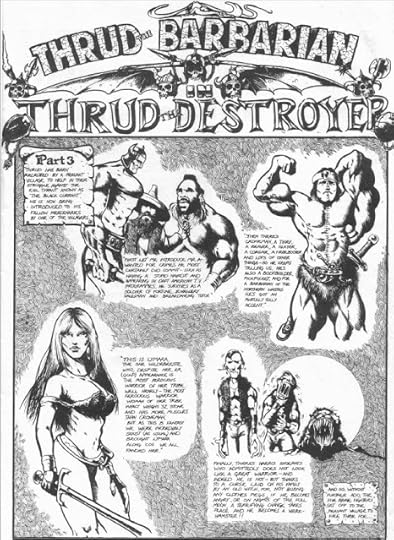 Graham Miller's "Smile Please" is an adventure for Traveller that is better in concept than execution. The characters are contracted to transport a mysterious box aboard a merchant vessel filled with a motley assortment of fellow passengers. As the ship enters jump space, some of these passengers start dying, seemingly as the result of a murderer in their midst. In truth, the whole thing is part of an Imperial version of the TV show, Candid Camera, which is a bit of a letdown. Mind you, I never ran this scenario, so perhaps it works well in play, though I have my doubts.
Graham Miller's "Smile Please" is an adventure for Traveller that is better in concept than execution. The characters are contracted to transport a mysterious box aboard a merchant vessel filled with a motley assortment of fellow passengers. As the ship enters jump space, some of these passengers start dying, seemingly as the result of a murderer in their midst. In truth, the whole thing is part of an Imperial version of the TV show, Candid Camera, which is a bit of a letdown. Mind you, I never ran this scenario, so perhaps it works well in play, though I have my doubts."Balancing Act" by Mike Lewis is an interesting early example of discussing the possible tension between the logic of drama (or "storytelling") and the unexpected outcomes of rules. Lewis suggests downplaying the role of rules to ensure a greater degree of dramatic coherence in a campaign and provides lots of examples and suggestions on how to handle this. His ultimate point is that the flow of a game session ought not to be broken by an errant dice roll or even the dictates of a rule. A good referee understands the need for judgment calls when in-game events dictate it. I find it hard to disagree, though leaning into this approach too heavily leads to the railroad and similar pathologies.
"The Sahuagin Heel" by Graeme Drysdale is a nice little AD&D adventure for characters of levels 2–4. The scenario involves a string of islands menaced by the aforementioned sahuagin. It's a solid sea-based adventure, with numerous interesting encounters, including tricks and traps. If it has a flaw, it's the extensive backstory presented at the start of the adventure to set the stage. In general, I prefer less of this sort of thing, but that's just personal preference. "The Other Imperium" by Michael Scott presents several civilian organizations for use with Traveller, like Intercredit (an intersellar banking service) and the Mercenary Monitoring Corps. Much more interesting is the latest installment of "The Travellers" comic, which has a go at Star Trek in forms of the characters of Captain Quirk and his first officer, Speck. We're also treated to more "Gobbledigook," though I almost missed it this time, because its placement amidst a sea of advertisements at the end of the issue obscured it somewhat.
"Forecasting the Runes" by Dave Morris and Oliver Johnson is an article for RuneQuest that presents two small rules/world additions to the game. The first is the titular runes, which function as a type of augury, while the second pertains to a system of birth signs based around the four parts of the soul (as understood by Glorantha's Lunar Empire). Both are quite flavorful and, just as importantly, mechanically simple, which I think is very important. Well done! Meanwhile, "The Noegyth Nibin" by Steven Prizeman stats up the "pettty dwarfs" of Tolkien's Silmarillion in D&D terms.
"Armed to the Teeth" by MJ Bourne is (yet another) collection of unusual historical weapons for use with D&D – stuff like the misericorde and poinard, alongside the boomerang and blowpipe. I don't hate articles like this, but I do question their utility after so many others have been written – and are still being written – that cover the same material. Finally, there's "Horse Sense" by Joe Dever and Gary Chalk in which they discuss the intricacies of painting horse miniatures for use with RPGs and tabletop wargames. As always, I find this series weirdly fascinating, perhaps because I know so little about miniatures painting.
And there you have it: issue #65 of White Dwarf. It's a better than average issue in my opinion, though a little more staid than earlier issues in the magazine's run. Unfortunately, that's the nature of these sorts of things. As a publication becomes more polished and "professional," its content is both more consistent and more "safe." Much as I have commented negatively about the inconsistency of White Dwarf's content in its early days, I nevertheless recognize that that inconsistency was, in some respects, a necessary consequence of its newness – the very same newness that regularly inspired some truly phenomenal creativity and that I'd love to see again.
February 13, 2023
RIP Donald Greer (1938–2022)
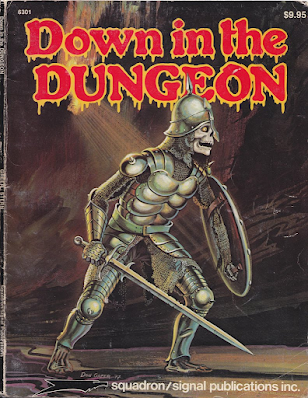 An inevitable – but nevertheless sad – feature of this blog since its beginning has been the reporting of the deaths of individuals associated with the hobby in its early days. Today, I regret to inform you that Donald Greer, artist of the 1981 book,
Down the Dungeon
, left this plane of existence in October of last year, . Thanks to Thaddeus Moore for alerting me to this information, of which I would otherwise have been unaware.
An inevitable – but nevertheless sad – feature of this blog since its beginning has been the reporting of the deaths of individuals associated with the hobby in its early days. Today, I regret to inform you that Donald Greer, artist of the 1981 book,
Down the Dungeon
, left this plane of existence in October of last year, . Thanks to Thaddeus Moore for alerting me to this information, of which I would otherwise have been unaware.As I explain in the post linked above, Down in the Dungeon occupies a special place in my memories, being inextricably linked to the first few years I started roleplaying. A neighborhood friend's older brother, who served as our mentor of sorts, owned a copy of Down in the Dungeon, which we regularly swiped from his basement bedroom whenever he was out of the house. A big part of the book's appeal to us was Mr Greer's artwork, which possessed the same kind of unpolished vibrancy that was a hallmark of RPG art from that era.
Reading his obituary, it seems that Mr Greer had a long and successful career as an artist, particularly of military aircraft – a reminder perhaps of the connections that used to exist between the worlds of fantasy and military history. You can see some examples of his illustrations, both fantastical and historical, here.
Rest in peace, Mr Greer.
February 12, 2023
Pulp Fantasy Gallery: The Dying Earth
Based on feedback, the revival of this series has been very well received, so I'll continue with it for a while longer, perhaps through the end of the month. Truth be told, I appreciate being able to take a break from Pulp Fantasy Library, which probably demands the most time and effort of anything I post here. To that end, let's take a look this week at the covers of one of the most influential books on the conception of Dungeons & Dragons – ot its Gygaxian iteration, at any rate – Jack Vance's 1950 collection, The Dying Earth.
Doing so is something of a cheat, since I actually posted about the original Hillman Periodicals cover at the dawn of this blog. However, I think it's more than worthwhile to be reminded of this cover (by an unknown artist) so as to be able to compare it to those that appeared on later editions of the book.
 The next edition of The Dying Earth appeared in 1962, published by Lancer and with a cover by Ed Mesh.
The next edition of The Dying Earth appeared in 1962, published by Lancer and with a cover by Ed Mesh.
 A UK edition from Mayflower appeared in 1972, with a cover by Chris Foss.
A UK edition from Mayflower appeared in 1972, with a cover by Chris Foss.
 Underwood-Miller produced a limited-run cloth edition of The Dying Earth in 1976, with this striking wrap-around cover by George Barr.
Underwood-Miller produced a limited-run cloth edition of The Dying Earth in 1976, with this striking wrap-around cover by George Barr.
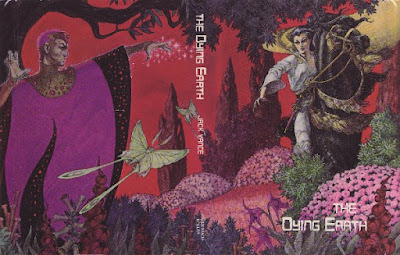 The first Pocket Books edition appeared in 1977 and featured this cover by the Brothers Hildebrandt.
The first Pocket Books edition appeared in 1977 and featured this cover by the Brothers Hildebrandt.
 Two years later, in 1979, Pocket Books reissued the collection, using a very different cover. This is, I believe, the first one I ever saw and so it's left a strong impression on my imagination ever since.
Two years later, in 1979, Pocket Books reissued the collection, using a very different cover. This is, I believe, the first one I ever saw and so it's left a strong impression on my imagination ever since.
 The 1985 UK edition from Panther/Grafton features this unusual cover by Geoff Taylor.
The 1985 UK edition from Panther/Grafton features this unusual cover by Geoff Taylor.
 We'll conclude this post with the last (English language) edition published in the 1980s, Baen's 1986 paperback, with cover artwork by Victoria Poyser.
We'll conclude this post with the last (English language) edition published in the 1980s, Baen's 1986 paperback, with cover artwork by Victoria Poyser.
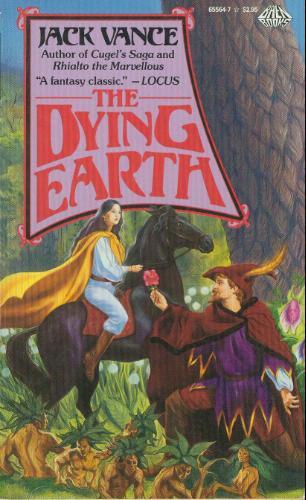
February 11, 2023
B2's "Notes for the Dungeon Master"
Of all the modules written by Gary Gygax, I suspect that The Keep on the Borderlands is his most widely played – not simply by virtue of its having been included in all printings of the Tom Moldvay-edited D&D Basic Set (and later printings of the J. Eric Holmes-edited version of the same), but because it's a solid, introductory scenario with which to kick off a campaign. Further, the first two pages of the modules are given over to a "Notes for the Dungeon Master" section that is filled with excellent advice for neophyte referees.
Consider the following:
The basic instruction book for DUNGEONS & DRAGONS® has given you the information to understand D&D and start play. This module is another tool. It is a scenario which will help you to understand the fine art of being a Dungeon Master as you introduce your group of players to your fantasy world, your interpretation of the many worlds of DUNGEONS & DRAGONS®. THE KEEP ON THE BORDERLANDS is simply offered as a vehicle for your use, a way to move smoothly and rapidly into you own special D&D campaign. Read the module thoroughly; you will notice that the details are left in your hands. This allows you to personalize the scenario, and suit it to what you and your players will find most enjoyable.
Looking beyond the overuse of the registered trademark every time the name "Dungeons & Dragons" is mentioned, Gygax says several important things here, starting with the fact that a module is merely a tool, indeed another tool, alongside the game's rulebook. That's why he quickly emphasizes the referee's ability to "personalize the scenario" according to one's own interpretation of D&D with the ultimate goal of enjoyment by oneself and one's players.
These are points Gygax repeats throughout these prefatory notes.
Become familiar with this module, then make whatever additions, changes, or amendments you feel are appropriate to your campaign ... As an aside, feel free to limit race or profession as suits your conception of the setting. You might disallow the presence of elves or halflings in the KEEP, or you might not want any thieves as beginning characters. It is all up to you as DM to decide the shape of the campaign. Likewise, you can opt to give the player characters a special item of equipment to begin with – possibly mounts, a weapon, some trade goods, or virtually anything of small value (within reason).
While I can completely understand, given his later statements on the matter of "official" D&D, Gygax's reputation as hard-nosed and uncompromising, that's not at all what comes across here. Throughout these notes, he is, if anything, open-minded and flexible. He is quick to highlight the referee's ability to alter both setting details and rules to suit his preferences and those of his players. A beginning DM very much needs to hear such things; he needs reassurance that it is completely within his role as referee to make D&D – and any module he uses – his own.
At the same time, Gygax acknowledges that the role of referee is not an easy one.
You not only must order and create the cosmos, you must also play the part of each and every creature that the player characters encounter. You must be gate guard and merchant, innkeeper and orc, oracle and madman, as the situation dictates. The role of DM is all-powerful, but it also makes many demands. It is difficult to properly play the village idiot at one moment and the sage the next, the noble clergyman on the one hand and the vile monster the other. In one role you must be cooperative, in the next uncaring and non-commital [sic], then foolish, then clever, and so on. Be prepared!
This is very well said and true in my experience. Gygax then goes to discuss the challenges of portraying monsters. All of what he says is fascinating, but some of it stands out in light of his later criticisms of "amateur thespianism" in the pages of Dragon.
When the players experience their first encounter with a monster, you must be ready to play the part fully. If the monster is basically unintelligent, you must have it act accordingly, enlivening the meeting with the proper dramatics of the animal sort – including noises! If the encounter is with a monster of a more intelligent sort, it is up to the DM to not only provide an exciting description but also to correctly act the part of the monster. Rats, for instance, will swarm chitteringly from their burrows – a wave of lice-ridden hunger seeking to consume the adventurrers with their sheer numbers, but easily driven off squealing with blows and fire. Goblins, on the other hand, will skulk and hide in order to ambush and trap the party – fleeing if overmatched, but always ready to set a new snare for the unwary character.
If nothing else, Gygax paints a compelling picture of what it must have been like to play at his table. At the same time, he does, I think, paint the job of the referee as a difficult, even off-putting one.
If all of this seems too much to handle, never fear! Just as your players are learning and gaining real experience at D&D, so too will you be improving your ability as DM. The work necessary to become a master of the art is great, far greater than that necessary to be a top player, but the rewards are proportionate. You will bring untold enjoyment to many players in your role as DM, and all the while you will have the opportunity to exercise your imagination and creative ability to the fullest. May each of your adventure episodes always be a wondrous experience!
Over the years, I've noted that fewer and fewer roleplayers seem interested in becoming referees, to the point where I frequently hear people bemoaning this fact. I can't speak to the way that most contemporary games present the role of the referee, but, if these complaints are true, I can't help but wonder if it's because they don't make it seem as compelling as Gygax does in the passage above – what a shame!
James Maliszewski's Blog
- James Maliszewski's profile
- 3 followers




